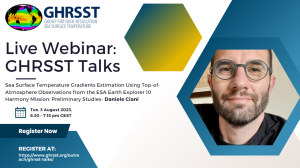
Thursday 3 August 2023
Time
From 6:30 pm-7:15 pm CEST
(check your timezone https://www.worldtimebuddy.com)
Sea Surface Temperature Gradients Estimation Using Top-of-Atmosphere Observations from the ESA Earth Explorer 10 Harmony Mission: Preliminary Studies
The Harmony satellite mission was recently approved as the next European Space Agency (ESA) Earth Explorer 10. The mission science objectives cover several applications related to solid earth, the cryosphere, upper-ocean dynamics and air–sea interactions. The mission consists of a constellation of two satellites, flying with the Copernicus Sentinel 1 (C or D) spacecraft, each hosting a C-band receive-only radar and a thermal infrared (TIR) payload. From an ocean dynamics/air–sea interaction perspective, the mission will provide the unique opportunity to observe simultaneously the signature of submesoscale upper-ocean processes via synthetic aperture radar and TIR imagery. The TIR imager is based on microbolometer technology and its acquisitions will rely on four channels: three narrow-band channels yielding observations at a ≃1 km spatial sampling distance (SSD) and a panchromatic (PAN, 8–12 μm) channel characterized by a ≃300 m SSD. Our study investigates the potential of Harmony in retrieving spatial features related to sea surface temperature (SST) gradients from the high-resolution PAN channel, relying on top-of-atmosphere (TOA) observations. Compared to a standard SST gradient retrieval, our approach does not require atmospheric correction, thus avoiding uncertainties due to inter-channel co-registration and radiometric consistency, with the possibility of exploiting the higher resolution of the PAN channel. The investigations were carried out simulating the future Harmony TOA radiances (TARs), as well as relying on existing state-of-the-art level 1 satellite products. Our approach enables the correct description of SST features at the sea surface avoiding the generation of spurious features due to atmospheric correction and/or instrumental issues. In addition, analyses based on existing satellite products suggest that the clear-sky TOA observations, in a typical mid-latitude scene, allow the reconstruction of up to 85% of the gradient magnitudes found at the sea-surface level. The methodology is less efficient in tropical areas, suffering from smoothing effects due to the high concentrations of water vapor.
Speaker’s profile
Dr Ciani received an MSc in Physics at the University of Rome “Sapienza” and a PhD in Physical Oceanography from Université de Bretagne Occidentale (UBO, Brest, FR). Dr Ciani’s research interests include satellite Sea Surface Temperature (SST) remote sensing, SST studies for ocean dynamics applications, SST diurnal warming and the development of future satellite missions for SST retrieval.
Registration
https://www.eventbrite.dk/e/sea-surface-temperature-gradients-estimation-tickets-577092859277
Resources
- Sea Surface Temperature Gradients Estimation Using Top-of-Atmosphere Observations from the ESA Earth Explorer 10 Harmony Mission: Preliminary Studies , https://doi.org/10.3390/rs15041163
- http://www.holoborodko.com/pavel/numerical-methods/numerical-derivative/smooth-low-noise-differentiators/
- This is the F2T2 task team within GHRSST: https://www.ghrsst.org/about-ghrsst/task-teams/task-team-on-feature-resolution/
